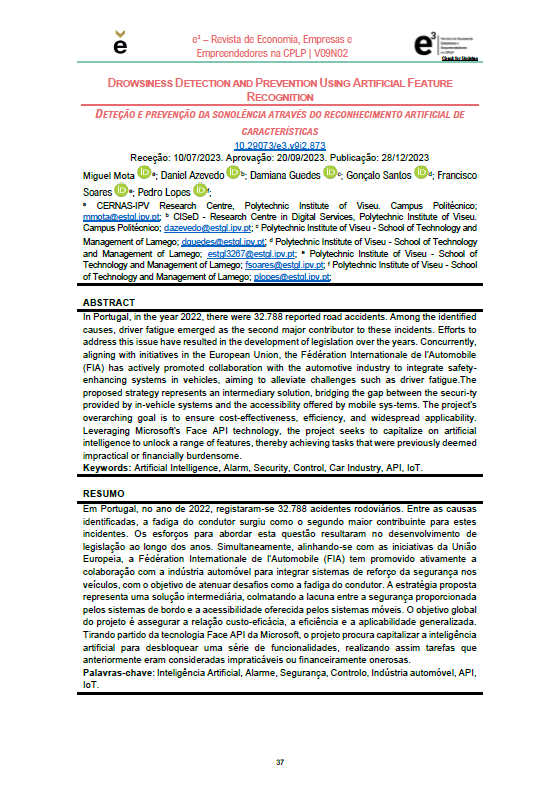DETEÇÃO E PREVENÇÃO DA SONOLÊNCIA ATRAVÉS DO RECONHECIMENTO ARTIFICIAL DE CARACTERÍSTICAS
Main Article Content
Resumo
Em Portugal, no ano de 2022, registaram-se 32.788 acidentes rodoviários. Entre as causas identificadas, a fadiga do condutor surgiu como o segundo maior contribuinte para estes incidentes. Os esforços para abordar esta questão resultaram no desenvolvimento de legislação ao longo dos anos. Simultaneamente, alinhando-se com as iniciativas da União Europeia, a Fédération Internationale de l'Automobile (FIA) tem promovido ativamente a colaboração com a indústria automóvel para integrar sistemas de reforço da segurança nos veículos, com o objetivo de atenuar desafios como a fadiga do condutor. A estratégia proposta representa uma solução intermediária, colmatando a lacuna entre a segurança proporcionada pelos sistemas de bordo e a acessibilidade oferecida pelos sistemas móveis. O objetivo global do projeto é assegurar a relação custo-eficácia, a eficiência e a aplicabilidade generalizada. Tirando partido da tecnologia Face API da Microsoft, o projeto procura capitalizar a inteligência artificial para desbloquear uma série de funcionalidades, realizando assim tarefas que anteriormente eram consideradas impraticáveis ou financeiramente onerosas.
Downloads
Article Details

Este trabalho encontra-se publicado com a Licença Internacional Creative Commons Atribuição 4.0.
Referências
AforgeTeam. (2019). AForge.NET: Computer Vision, Artificial Intelligence, Robotics. Retrieved April 19, 2023, from http://www.aforgenet.com/framework/
ANSR/MAI, P. (2018). Acidentes de viação com vítimas, feridos e mortos - Continente. PorData. Retrieved April 19, 2023, from https://www.pordata.pt/Portugal/Acidentes+de+via%c3%a7%c3%a3o+com+v%c3%adtimas++feridos+e+mortos+++Continente-326-3587
Ataei, M., Esmaeilpour, A., & Yousefi, M. R. (2019). Driver drowsiness detection using facial landmark estimation and eye aspect ratio. Measurement, 139, 373-381.
Azati (2019) reports on the cost of artificial intelligence (AI) in 2019. Retrieved from https://azati.ai/how-much-does-it-cost-to-utilize-machine-learning-artificial-intelligence/
Bizdirect. (2019). Quem somos. Retrieved April 19, 2023, from https://www.bizdirect.pt/pt/quem-somos
C# DESIGN GOALS. (2011, January 23). Retrieved April 19, 2023, from https://feeldotneteasy.blogspot.com/2011/01/c-design-goals.html
Choi, Y., Jeong, J., & Lee, J. (2021). Driver drowsiness detection using facial land-marks, head movement, and bio-signal features with deep learning. IEEE Transactions on Intelligent Transportation Systems. https://doi.org/10.1109/TITS.2021.3119049
Dlib.net. DLIB C++ Library. http://dlib.net/
Guru99. (2019). What is Soak Testing? Definition, Meaning, Examples. Available at: https://www.guru99.com/soak-testing.html [Accessed: April 19, 2023].
Hall-Geisler, K. (2019). How Anti-sleep Alarms Work. Available at: https://electronics.howstuffworks.com/gadgets/automotive/anti-sleep-alarm.htm [Ac-cessed: April 19, 2023].
IDEOU. (2019, August 4). Design Thinking. IDEO U. https://www.ideou.com/pages/design-thinking
Jafari, S. A., Zanjanizadeh Ezazi, M. P., Torkamani, M. J., & Rahimpour, A. (2021). An overview of deep learning in medical imaging: Focus on MRI. Journal of Medical Signals and Sensors, 11(3), 137-151.
Kim, H., Yoo, J., & Han, J. (2021). A Comparative Study on Driver Drowsiness Detec-tion Systems based on Facial Landmark Estimation and Machine Learning Techniques. Sensors, 21(11), 3875.
Kim, M., Lee, W., & Choi, S. (2020). Real-Time Driver Drowsiness Detection System based on Facial Features using Convolutional Neural Network. Journal of Advanced Transportation, 2020. doi: 10.1155/2020/8827386.
Lee, H., Lee, S., & Lee, S. (2022). Driver Drowsiness Detection System Based on Facial Landmarks and Artificial Neural Network. Sensors, 22(3), 957.
Liu, Y., Wang, Z., Lv, Z., & Sun, J. (2017). Driver Drowsiness Detection using Dynam-ic Facial Analysis. IEEE Transactions on Intelligent Transportation Systems, 18(4), 945-954.
Mercedes-Benz. (2019, August 4). Safety. Mercedes-Benz USA. https://www.mbusa.com/mercedes/benz/safety#module-3
Microsoft. (2019, August 11). Azure Cognitive Services. Microsoft Azure. https://azure.microsoft.com/en-us/support/legal/cognitive-services-compliance-and-privacy/
Microsoft. (2019, August 11). Windows Presentation Foundation. Microsoft. https://docs.microsoft.com/en-us/dotnet/framework/wpf/
Microsoft. (2019, August 13). IntelliSense. Microsoft. https://code.visualstudio.com/docs/editor/intellisense
Microsoft. (2019, August 13). SQL Server. Microsoft. https://www.microsoft.com/en-us/sql-server/sql-server-2017
Microsoft. (2019, August 13). The History of C#. Microsoft. https://docs.microsoft.com/en-us/dotnet/csharp/whats-new/csharp-version-history
Microsoft. (2019, August 13). Visual Studio. Microsoft. https://visualstudio.microsoft.com/vs/
Microsoft. (2019, August 4). Face Detection and Attributes. Microsoft Azure. https://docs.microsoft.com/en-us/azure/cognitive-services/face/concepts/face-detection
Microsoft. (2019, June 25). Face API - Facial Recognition Software | Microsoft Azure. Microsoft Azure. https://azure.microsoft.com/en-us/services/cognitive-services/face/
Oppel, A. (2004). Databases Demystified. McGraw-Hill Osborne Media.
Oracle. (2019, August 13). History of SQL. Oracle. https://docs.oracle.com/cd/B12037_01/server.101/b10759/intro001.htm
Ozkan, M. & Turk, M. (2017). Driver drowsiness detection based on shape and texture analysis of facial images. Image and Vision Computing, 57, 38-46.
Plattner, H., Meinel, C., & Leifer, L. J. (2011). Design thinking: Understand, improve, apply. Berlin: Heidelberg.
PORDATA. (2022). Acidentes de viação com vítimas - Total e por tipo de acidente. PORDATA - Base de Dados de Portugal Contemporâneo. https://www.pordata.pt/
RoSPA. (2019, August 11). Driver Fatigue and Road Accidents - a Literature Review and Position Paper. Road Safety Knowledge Centre. http://www.roadsafetyknowledgecentre.org.uk/knowledge/545.html
Santos, G., Lopes, P., Guedes, D., Azevedo, D., & Soares, F. (2023). Drowziness pre-vention system based on artificial intelligence facial features detection. Special Issue - ICE2MAS, 92-99.
Singh, P., Bajaj, P., & Gupta, S. (2017). A Vision-Based System for Driver Drowsiness Detection using Pupil Detection and Mouth Detection. In 2017 International Conference on Computing, Communication and Automation (ICCCA) (pp. 935-940). IEEE.
Sun, H. F., Park, S. S., & Cho, S. H. (2018). Facial landmarks-based driver drowsiness detection using deep neural networks. Neural Computing and Applications, 30(10), 3177-3186.
TECH, T. (2019, August 5). Nap Zapper. TBO TECH. https://www.tbotech.com/napzapper.htm
Volvo. (2019, August 4). Driver Alert Control. YouTube. https://www.youtube.com/watch?v=sVDTnFeutOs
Zaidi, B., Ilyas, M. U., & Imran, A. (2020). Driver Drowsiness Detection Based on Fa-cial Features using Machine Learning Techniques. International Journal of Advanced Computer Science and Applications, 11(7), 87-93.





